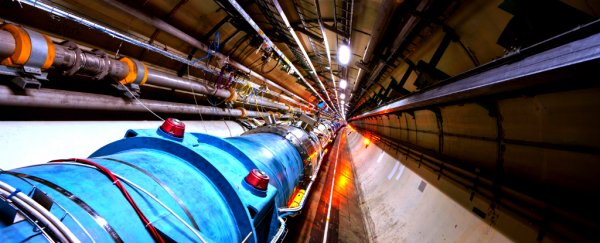The Large Hadron Collider below Switzerland and France has just accelerated its first atoms to almost the speed of light, and the results have "exceeded predictions".
The test was an exciting proof-of-concept that could lead to a new series of groundbreaking experiments and potentially even new types of matter, such as dark matter.
Usually, the LHC is famous for accelerating beams of protons to crazy speeds around the 27 kilometre (17 mile) long tunnel and smashing them into each other to see what weird, wonderful, and new particles fall out.
Experiments at the LHC led to the discovery of the Higgs boson in 2012, and since then have given us a slew of strange new subatomic particles, tantalising hints of new physics, as well as helping to confirm the limits of reality.
But despite a decade of experiments, this is the first time researchers have injected not just atomic nuclei into the machine, but lead atoms containing a single electron.
The experiment is a proof-of-concept for a new idea called the Gamma Factory, which would see the LHC turn into a gamma ray factory capable of producing massive particles and even new kinds of matter, such as dark matter.
"We're investigating new ideas of how we could broaden the present CERN research program and infrastructure," says LHC engineer Michaela Schaumann.
"Finding out what's possible is the first step."
Every year in the four weeks leading up to the annual winter shutdown, researchers experiment and swap out proton collisions for atomic nuclei.
But this year, they spent a few days testing something new - accelerating entire atoms.
The reason scientists have never done this before is because lead atoms are fragile, and it's incredibly easy to accidentally strip off the electron, which causes the nucleus to crash into the wall of the beam pipe.
Blasting high energy beams of atoms into a very expensive machine surrounded by sensitive magnets is, as you can imagine, not ideal.
So in the lead up to this test, the physicists first accelerated xenon nuclei in the LHC, and they also tested out partially stripped lead ions in the Super Proton Synchrotron, which is the second largest accelerator at CERN.
Injecting the lead atoms into the LHC was the final step.
During the first run, the team injected 24 bunches of atoms and achieved a low-energy stable beam inside the LHC for about an hour.
Then they turned the LHC up to full power and maintained the beam for about two minutes before it shut down.
"If too many particles go off course, the LHC automatically dumps the beam," says Schaumann. "Our main priority is to protect the LHC and its magnets."
After a magnet reset, the team then tried again using only six bunches of atoms – and this time were able to keep the beam circulating for two hours before they intentionally dumped it.
"We predicted that the lifetime of this special kind of beam inside the LHC would be at least 15 hours," says physicist Witold Krasny, who's leading a team of researchers investigating the atom experiments.
"We were surprised to learn the lifetime could be as much as about 40 hours. Now the question is if we can preserve the same beam lifetime at a higher intensity by optimising the collimator settings, which were still set up for protons during this special run."
If researchers can optimise these atom beams, the next step would be to shoot the circulating atoms with a laser, causing the electron to jump up into a higher energy level.
As the electron drops down again, it shoots out the energy as a particle of light.
But inside the LHC the atom would be moving close to the speed of light, and so the energy of the particle of light would be incredibly high, and its wavelength would be squeezed, turning it into a gamma ray.
These gamma rays would be powerful enough to produce particles such as quarks, electrons, and muons. And they would also be able to transform into massive particles and potentially even new types of matter, such as dark matter.
"They could also be the source for new types of particle beams, such as a muon beam," a CERN press release explains.
We have a long way to go, but this is an exciting first step that could lead to a new era of science at the LHC. We can't wait.
